Seyit A. Camtepe
Vertical Federated Learning: Taxonomies, Threats, and Prospects
Feb 03, 2023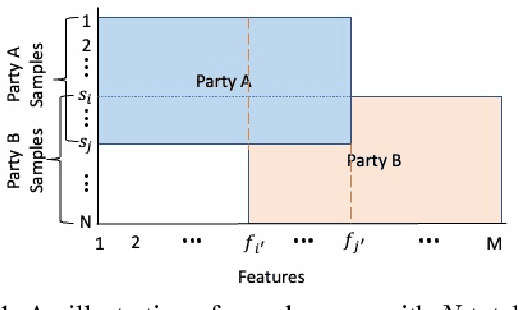
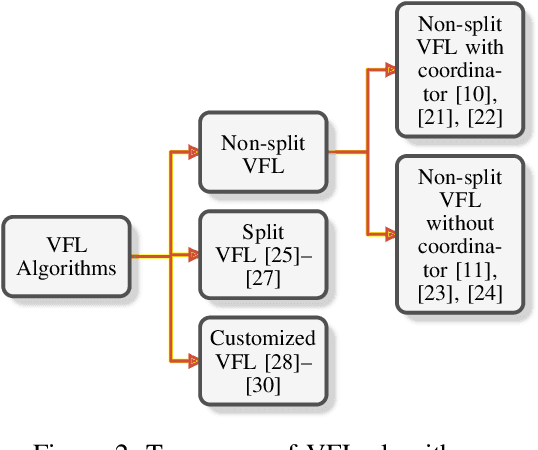
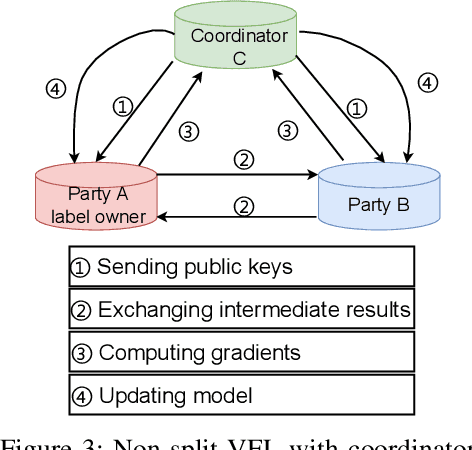
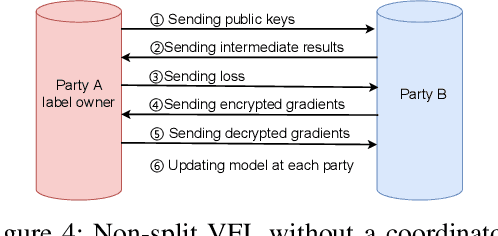
Abstract:Federated learning (FL) is the most popular distributed machine learning technique. FL allows machine-learning models to be trained without acquiring raw data to a single point for processing. Instead, local models are trained with local data; the models are then shared and combined. This approach preserves data privacy as locally trained models are shared instead of the raw data themselves. Broadly, FL can be divided into horizontal federated learning (HFL) and vertical federated learning (VFL). For the former, different parties hold different samples over the same set of features; for the latter, different parties hold different feature data belonging to the same set of samples. In a number of practical scenarios, VFL is more relevant than HFL as different companies (e.g., bank and retailer) hold different features (e.g., credit history and shopping history) for the same set of customers. Although VFL is an emerging area of research, it is not well-established compared to HFL. Besides, VFL-related studies are dispersed, and their connections are not intuitive. Thus, this survey aims to bring these VFL-related studies to one place. Firstly, we classify existing VFL structures and algorithms. Secondly, we present the threats from security and privacy perspectives to VFL. Thirdly, for the benefit of future researchers, we discussed the challenges and prospects of VFL in detail.
A Game-Theoretic Approach for AI-based Botnet Attack Defence
Dec 04, 2021
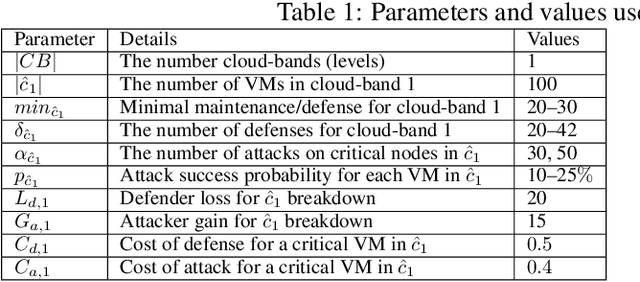


Abstract:The new generation of botnets leverages Artificial Intelligent (AI) techniques to conceal the identity of botmasters and the attack intention to avoid detection. Unfortunately, there has not been an existing assessment tool capable of evaluating the effectiveness of existing defense strategies against this kind of AI-based botnet attack. In this paper, we propose a sequential game theory model that is capable to analyse the details of the potential strategies botnet attackers and defenders could use to reach Nash Equilibrium (NE). The utility function is computed under the assumption when the attacker launches the maximum number of DDoS attacks with the minimum attack cost while the defender utilises the maximum number of defense strategies with the minimum defense cost. We conduct a numerical analysis based on a various number of defense strategies involved on different (simulated) cloud-band sizes in relation to different attack success rate values. Our experimental results confirm that the success of defense highly depends on the number of defense strategies used according to careful evaluation of attack rates.
Evaluation and Optimization of Distributed Machine Learning Techniques for Internet of Things
Mar 03, 2021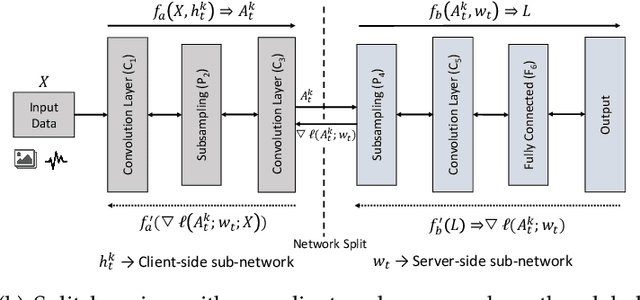

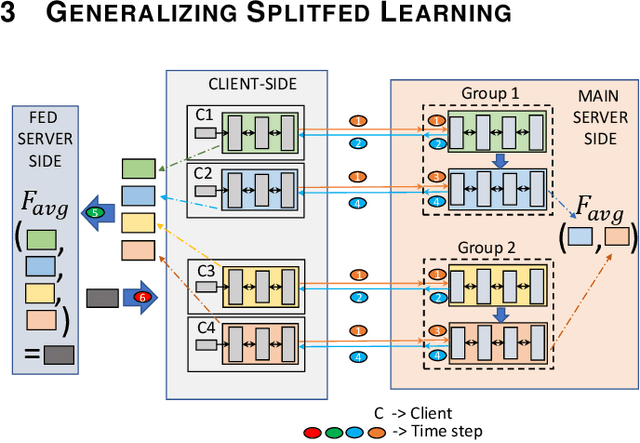
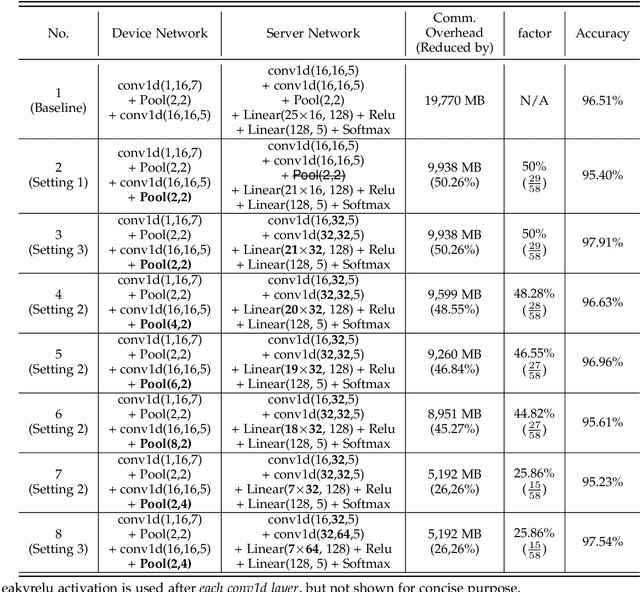
Abstract:Federated learning (FL) and split learning (SL) are state-of-the-art distributed machine learning techniques to enable machine learning training without accessing raw data on clients or end devices. However, their \emph{comparative training performance} under real-world resource-restricted Internet of Things (IoT) device settings, e.g., Raspberry Pi, remains barely studied, which, to our knowledge, have not yet been evaluated and compared, rendering inconvenient reference for practitioners. This work firstly provides empirical comparisons of FL and SL in real-world IoT settings regarding (i) learning performance with heterogeneous data distributions and (ii) on-device execution overhead. Our analyses in this work demonstrate that the learning performance of SL is better than FL under an imbalanced data distribution but worse than FL under an extreme non-IID data distribution. Recently, FL and SL are combined to form splitfed learning (SFL) to leverage each of their benefits (e.g., parallel training of FL and lightweight on-device computation requirement of SL). This work then considers FL, SL, and SFL, and mount them on Raspberry Pi devices to evaluate their performance, including training time, communication overhead, power consumption, and memory usage. Besides evaluations, we apply two optimizations. Firstly, we generalize SFL by carefully examining the possibility of a hybrid type of model training at the server-side. The generalized SFL merges sequential (dependent) and parallel (independent) processes of model training and is thus beneficial for a system with large-scaled IoT devices, specifically at the server-side operations. Secondly, we propose pragmatic techniques to substantially reduce the communication overhead by up to four times for the SL and (generalized) SFL.
Advancements of federated learning towards privacy preservation: from federated learning to split learning
Nov 25, 2020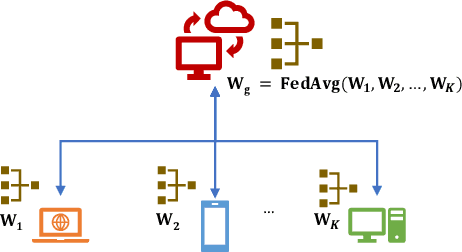

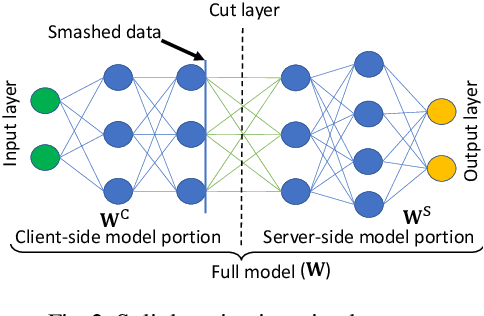
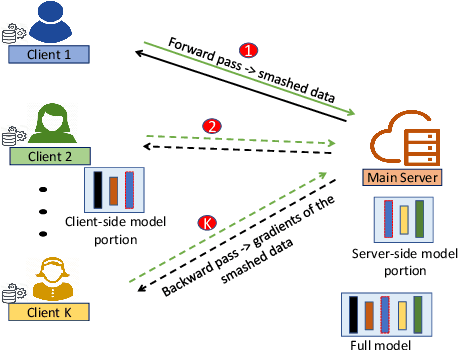
Abstract:In the distributed collaborative machine learning (DCML) paradigm, federated learning (FL) recently attracted much attention due to its applications in health, finance, and the latest innovations such as industry 4.0 and smart vehicles. FL provides privacy-by-design. It trains a machine learning model collaboratively over several distributed clients (ranging from two to millions) such as mobile phones, without sharing their raw data with any other participant. In practical scenarios, all clients do not have sufficient computing resources (e.g., Internet of Things), the machine learning model has millions of parameters, and its privacy between the server and the clients while training/testing is a prime concern (e.g., rival parties). In this regard, FL is not sufficient, so split learning (SL) is introduced. SL is reliable in these scenarios as it splits a model into multiple portions, distributes them among clients and server, and trains/tests their respective model portions to accomplish the full model training/testing. In SL, the participants do not share both data and their model portions to any other parties, and usually, a smaller network portion is assigned to the clients where data resides. Recently, a hybrid of FL and SL, called splitfed learning, is introduced to elevate the benefits of both FL (faster training/testing time) and SL (model split and training). Following the developments from FL to SL, and considering the importance of SL, this chapter is designed to provide extensive coverage in SL and its variants. The coverage includes fundamentals, existing findings, integration with privacy measures such as differential privacy, open problems, and code implementation.
FedEmail: Performance Measurement of Privacy-friendly Phishing Detection Enabled by Federated Learning
Jul 27, 2020



Abstract:Artificial intelligence (AI) has been applied in phishing email detection. Typically, it requires rich email data from a collection of sources, and the data usually contains private information that needs to be preserved. So far, AI techniques are solely focusing on centralized data training that eventually accesses sensitive raw email data from the collected data repository. Thus, a privacy-friendly AI technique such as federated learning (FL) is a desideratum. FL enables learning over distributed email datasets to protect their privacy without the requirement of accessing them during the learning in a distributed computing framework. This work, to the best of our knowledge, is the first to investigate the applicability of training email anti-phishing model via FL. Building upon the Recurrent Convolutional Neural Network for phishing email detection, we comprehensively measure and evaluate the FL-entangled learning performance under various settings, including balanced and imbalanced data distribution among clients, scalability, communication overhead, and transfer learning. Our results positively corroborate comparable performance statistics of FL in phishing email detection to centralized learning. As a trade-off to privacy and distributed learning, FL has a communication overhead of 0.179 GB per global epoch per its clients. Our measurement-based results find that FL is suitable for practical scenarios, where data size variation, including the ratio of phishing to legitimate email samples, among the clients, are present. In all these scenarios, FL shows a similar performance of testing accuracy of around 98%. Besides, we demonstrate the integration of the newly joined clients with time in FL via transfer learning to improve the client-level performance. The transfer learning-enabled training results in the improvement of the testing accuracy by up to 2.6% and fast convergence.
End-to-End Evaluation of Federated Learning and Split Learning for Internet of Things
Mar 30, 2020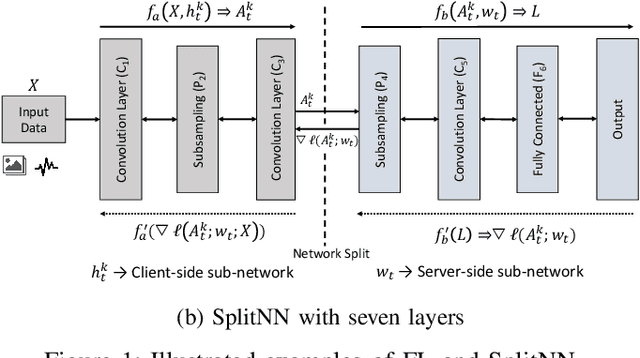



Abstract:This work is the first attempt to evaluate and compare felderated learning (FL) and split neural networks (SplitNN) in real-world IoT settings in terms of learning performance and device implementation overhead. We consider a variety of datasets, different model architectures, multiple clients, and various performance metrics. For learning performance, which is specified by the model accuracy and convergence speed metrics, we empirically evaluate both FL and SplitNN under different types of data distributions such as imbalanced and non-independent and identically distributed (non-IID) data. We show that the learning performance of SplitNN is better than FL under an imbalanced data distribution, but worse than FL under an extreme non-IID data distribution. For implementation overhead, we end-to-end mount both FL and SplitNN on Raspberry Pis, and comprehensively evaluate overheads including training time, communication overhead under the real LAN setting, power consumption and memory usage. Our key observations are that under IoT scenario where the communication traffic is the main concern, the FL appears to perform better over SplitNN because FL has the significantly lower communication overhead compared with SplitNN, which empirically corroborate previous statistical analysis. In addition, we reveal several unrecognized limitations about SplitNN, forming the basis for future research.
Can We Use Split Learning on 1D CNN Models for Privacy Preserving Training?
Mar 16, 2020



Abstract:A new collaborative learning, called split learning, was recently introduced, aiming to protect user data privacy without revealing raw input data to a server. It collaboratively runs a deep neural network model where the model is split into two parts, one for the client and the other for the server. Therefore, the server has no direct access to raw data processed at the client. Until now, the split learning is believed to be a promising approach to protect the client's raw data; for example, the client's data was protected in healthcare image applications using 2D convolutional neural network (CNN) models. However, it is still unclear whether the split learning can be applied to other deep learning models, in particular, 1D CNN. In this paper, we examine whether split learning can be used to perform privacy-preserving training for 1D CNN models. To answer this, we first design and implement an 1D CNN model under split learning and validate its efficacy in detecting heart abnormalities using medical ECG data. We observed that the 1D CNN model under split learning can achieve the same accuracy of 98.9\% like the original (non-split) model. However, our evaluation demonstrates that split learning may fail to protect the raw data privacy on 1D CNN models. To address the observed privacy leakage in split learning, we adopt two privacy leakage mitigation techniques: 1) adding more hidden layers to the client side and 2) applying differential privacy. Although those mitigation techniques are helpful in reducing privacy leakage, they have a significant impact on model accuracy. Hence, based on those results, we conclude that split learning alone would not be sufficient to maintain the confidentiality of raw sequential data in 1D CNN models.
 Add to Chrome
Add to Chrome Add to Firefox
Add to Firefox Add to Edge
Add to Edge